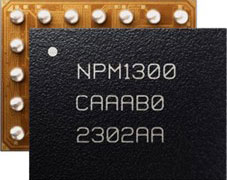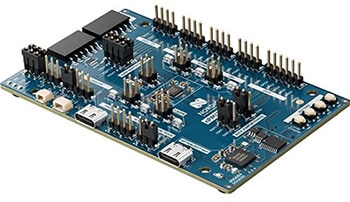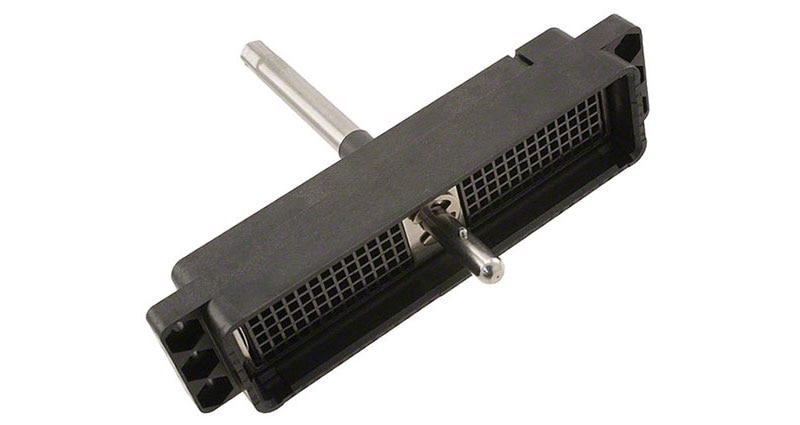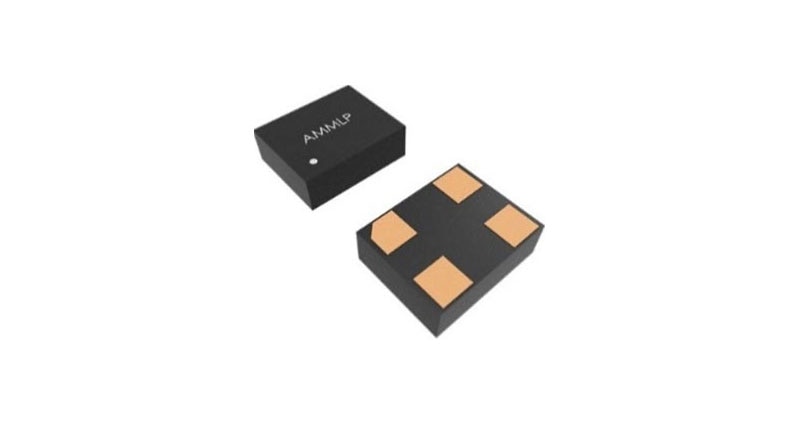Fewer Components, Code-Free Configuration with Nordic Power Management ICs
Design requirements for new rechargeable wireless applications are simple: make devices operate longer and cram in more features. Achieving the right balance between performance and power typically requires navigating multiple trade-offs, starting with component selection and mediating hardware and software issues.
Nordic Semiconductor aims to simplify that challenge with power management integrated circuits (PMICs) that incorporate intelligent system management features to eliminate the need for multiple discrete components and code-free configuration.
Nordic's nPM1300 series are versatile, integrated PMICs that support various Nordic—and non-Nordic—host devices for applications such as wearables, handheld entertainment units, IoT sensors, or personal medical equipment.
The PMIC portfolio incorporates a charger capable of up to 800 mA and delivering up to 500 mA of adjustable regulated voltage. The ICs also incorporate four individually controllable power rails: two configurable, dual-mode BUCK regulators, and two dual-purpose 50 mA LDO/100 mA load switches (which can function as switches or linear voltage regulators).
The nPM1300s also incorporate a fuel gauge that enables a host device to read battery temperature, voltage, and current. Designers can take advantage of state-of-charge estimates comparable to coulomb counters at significantly lower power consumption.
Eight-into-one
Other integrated features include a system-level watchdog and a hard reset. By Nordic's account, product designers using its PMICs can consolidate into one compact package the functions of eight chips and additional components typically implemented as discrete components in Bluetooth Low Energy (BLE) embedded designs.
The onboard charger can recharge Li-ion, Li-polymer, or LiFePO4 batteries. Battery packs connected to the VBAT pin must contain circuitry for overvoltage protection, undervoltage protection, overcurrent discharge protection, and a thermal fuse to protect from overtemperature unless an NTC thermistor is present. The nPM1300 line also supports USB-C for power and data communication.
The nPM1300-CAAA-R (Figure 1) comes in a 3.1 x 2.4 mm WLCSP package. Others, like the nPM1300-QEAA-R7, come in 5 x 5 mm QFN32 packaging.
 Figure 1: Representation of Nordic Semiconductors nPM1300 Power Management ICs. (Image source: Nordic Semiconductor)
Figure 1: Representation of Nordic Semiconductors nPM1300 Power Management ICs. (Image source: Nordic Semiconductor)
Configuring an nPM1300
Designers can configure all settings of an nPM1300 using the GUI of the nPM PowerUp app that Nordic makes available in its nRF Connect desktop software. Once configured, settings can be exported as code to be implemented in an MCU's application.
The configuration app can also be used with Nordic's nPM1300-EK evaluation board (Figure 2), which aims to make it easier to evaluate and implement an nPM1300. The evaluation board's male pin headers provide access to all nPM1300 PMIC connections and external test equipment; three LEDs and four pushbuttons are implemented for evaluating an nPM1300 PMIC's GPIO and LED driver functionality.
 Figure 2: The nPM1300-EK board for more easily configuring and implementing nPM1300 power management ICs. (Image source: Nordic Semiconductor)
Figure 2: The nPM1300-EK board for more easily configuring and implementing nPM1300 power management ICs. (Image source: Nordic Semiconductor)
Nordic also offers the nPM-FG fuel gauge board extension that functions as a constant current sink device during battery profiling. The PMICs, configuration software, evaluation kit, and fuel gauge board extension can be used to profile the power source and develop a model that will provide stable and precise state-of-charge predictions, with a typical error of less than ±3%.
The nPM PowerUP-generated battery model can be exported for use in any application using Nordic's fuel gauge algorithm. That algorithm can be run on most Nordic hosts and is compatible with other non-Nordic SoCs.
Conclusion
To meet the challenges of creating new battery-operated devices, product designers must pack more functionality and features into smaller packages. Nordic Semiconductor's nPM1300 line provides powerful and versatile power management for designing systems with long life, small form factor, and high performance. Nordic's PMICs incorporate multiple power and system management features, while its evaluation boards and software tools enable designers to configure and optimize rechargeable applications.

Have questions or comments? Continue the conversation on TechForum, DigiKey's online community and technical resource.
Visit TechForum









